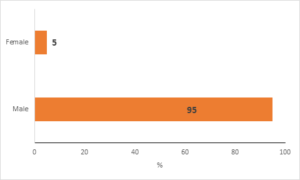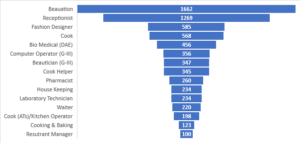Background
Evidence-based employment policy-making requires identifying and quantifying the best practices and inefficiencies in the job market, such as underutilization of skilled workforce and lack of decent job opportunities. This is the first step in designing employment policies aimed at enhancing the well-being of workers while also aiding economic growth. Such comprehensive view of the world of work calls for collection, organization and analysis of necessary labour market information. In this context, the information on skills demand can serve as a tool for monitoring and assessment of many issues related to functioning of labour markets.
Right assessment of skills gap in the labour market assists policy makers in formulating relevant policies and programmes that enhance the quality and diversity of skills supplied to job market, thus resulting in improved business climate. Regular assessment and anticipation of the skills gap can enable policy makers to improve the skills development sector and to produce a skilled workforce which meets the requirements of the industry. This is essential for improving the productivity and competitiveness of the country’s skilled workforce, which can help attract investment and foster higher economic gains. The skills mismatch in the labour market is the result of lack of standardization and coordination among the training providers/TVET authorities and employers.
The main objectives of the NSIS Cell are to:
- Provide reliable national skills information for development of the workforce in more employable skills;
- Provide timely and accurate information for demand and supply analysis to TVET planners, training institutes, industry, academia, students and public in general; and
- Establish and facilitate career/vocational guidance and placement services for TVET graduates and potential employers.
It is essential to have a complete overview of skilled workforce supply and skills that are demanded by the industry. The regional, level and gender wise mismatch in the demand and supply is one of the biggest causes of unemployment of the TVET graduates as well as lack of competitiveness of the industrial sector in Pakistan. To ensure provision of reliable information to stakeholders for addressing these and related issues, it is imperative to collect job-related data from the labour markets and enrolment/supply side from TVET institutions.
In national labour market the share of female in annual supply is around 36%, against 6% female specific annual demand (against supply related trades), the main reason of mismatch is the supply of the female in some specific trades like, dress making, fashion designing and beautician. Although it is fact that in information technology the female participation is lowest in south Asia countries, have potential for female related jobs opportunities. On the others side the allied health services also have much better opportunities in labour market.
Pakistan’s labor market has the 9th largest labor force in the world comprising of 65.50 million males & females according to the Labor Force Survey 2017-18. Where, 50.74 m (77.47%) Males + 14.76 m (22.53%) Females, and 42.91 m (65.51%) Rural + 22.59 m (34.49%) Urban. Thus, making it an overall Labor Force Participation Rate of 44.28%. While segregating through gender, she cleared that Male LFPR is 67.99% and Female LFPR is 20.14% (lowest in South Asian Region). This makes the Overall Unemployment Rate of 5.79% (Male UR = 5.07% & Female UR = 8.27%).
The percentages in the graph shown in Figure 1 give a bleak picture of gender participation
in the provincial labour market that is dominated by male gender with 95% share. The share of female participation in provincial labour market is only 5% which is comparatively lower than the overall national female participation rate which is 25.12%3. The low participation of women in the economy is a discouraging factor for sustainable economic growth and socio-economic development of the province. The underlying factor to this low participation is the engagement of women in household activities, agriculture sector and them having access to fewer numbers of opportunities in the job market, as indicated in the Figure 2. Encouraging women participation through social dialogue, extending career counselling services and creating employment opportunities are some of the policy interventions which may need to be taken immediately for reducing unemployment and gender equality.
Figure 1: Gender participation Provincial labour market
Figure 2 identifies the top ten demand driven trades for women along with the number of jobs available. Since the agriculture sector has not been covered in the survey, the survey reports only the traditional female specific occupations for example; beautician, receptionist, fashion designing and cook. The low participation of female workers in the provincial labour market can be attributed to the smaller number of job opportunities available in the market and their participation in household
economy.
Figure 2: Female specific demand
Causes of poor female participation
Based on facts and evidence from both the developed and developing world demonstrates that increasing gender equality is a key driver of economic growth. Linkages between female participation rates and economic growth rates are quite clear, and the strong positive correlation between women’s position in society and economic development holds true across countries and time.
Generally, women’s participation in the formal labor labour market is limited by social constraints that restricts their mobility and entrusts them to the domestic sphere. The second factor fertility rates are high with an average of 4 children per woman. The third factor maternal mortality rate of 275 per 100,000 is also higher than the national average. The fourth factor literacy rate is 36 percent for women (compared to 72 percent for men). The fifth factor Women are largely confined to unpaid domestic labor, animal husbandry and agriculture work, though their degree of their involvement in formal and informal labor markets varies by location.
Based on statistics “skilled workforce demand in KP” is very high in hospitality, allied health services and informal labour market with strong linkages with formal labour market.
Recommendations
- Female participation in labour market should be improved. A start would be to offer them courses in demand driven trades other than those traditionally considered female oriented trades. In this regard, hospitality and IT sectors must be explored for skills development of women.
- Career counselling services should be extended to school and college levels to encourage women to acquire vocational skills and become part of the job market. Moreover, employers should be encouraged to have more inclusive hiring policies and make the work environment more welcoming towards female recruits.
- Traditional curricula must be phased out or consolidated with the CBT Qualifications designed in consultation with the employers and industry experts to bring academia more in line with the HR needs of the industry and to improve employability of the pass-outs.
- Entrepreneurial trainings should be incorporated in the TVET courses to encourage self-employment and job creation.
- A smart mechanism for collecting feedback from the employers may be devised, where their feedback on matters, such as curricula contents, training and assessment methods, and employability of the trainees, could easily be given and accessed by stakeholders.

 GIZ Gender Website
GIZ Gender Website
